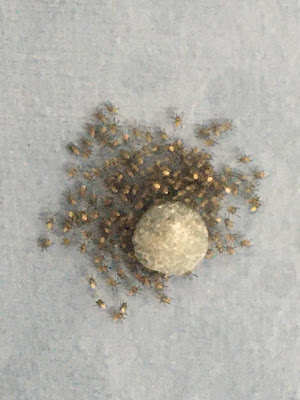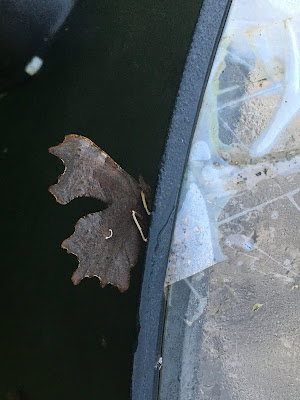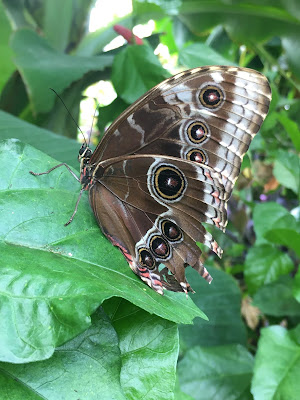The artful cocoon of twigs, leaves and even a bit of pea netting which my Elephant Hawk caterpillar span a month or so ago -
as described here - has now dried out to the extent where I can safely make a small 'window' for the grandchildren - and you - to peek inside. Here is the pupa, the armoured shell within which the astonishing change from a fat caterpillar to a trim moth will take place between now and next May.

The transformation seems slightly less dramatic when you look at this picture of a Large Yellow Underwing which I found upside-down near the light trap at the weekend. The stripes of the plump body have an undoubted resemblance to the patterned chrysalis of the Elephant Hawk.
Meanwhile a neighbour kindly sent me this picture of a Dark Dagger moth's caterpillar, probably on its way to find its own secret site for spinning a cocoon. It's very much that time of the year and the end of the long, calm spell - lovely weather but bad for the UK's increasing investment in wind-powered electricity generation - has just signalled the onset of Autumn.
Another sign of the changing seasons is the appearance of Autumnal moths such as the bright Barred Sallow above, beyond a Beautiful Hook-tip, and below, on its own and closer-to. The Sallow family have taken over from the Brimstone moth the task of adding a cheerful gleam to the ranks of the duller moths in the eggboxes.
The Bordered Beauty and Oak Hook-tip below is both another such and the funny little Spectacle in the third picture is also bringer of variety and pleasure. Actually the 'specs' are perched above the moth's actual eyes, but the effect is very endearing (and perhaps a deterrent to predators).
Now for some of the afore-mentioned drabber or less showy bretheren - thoough, as I have often mentioned, their colours and especially patterns have great appeal. I have captioned them for ease of putting two and two together, rather than listing them in advance:
 |
| Willow Beauty - the second generation are smaller |
 |
| I think that this is a lightly-marked Lunar Underwing but am checking with Upper Thames Moths |
 |
| Black Rustic with its slanted golden 'eyes' |
 |
| Here is one of the two other colourways of Lunar Underwing |
 |
| And lastly an Autumnal Rustic - the name says it all |
In the butterfly world, by contrast, Autumn is a time of vivid colour as Red Admirals take over from the Peacocks and Small Tortoiseshells which brought such delight in the Summer. They love buddleia, the one plant among the many on garden centres' optimistic lists, which really will attract butterflies to your garden. Here are two in the grandchildren's garden and a third basking on a sunny wall of our house, a practice which they alternate with sessions sipping nectar from the purple-flowered and honey-scented bushes.
And now for a change: behold the vast family of a single spider, followed by a Henley Regatta Blazer Beetle - actually a Rosemary Beetle, a species which only arrived in the UK from South America in the 1990s but has since spread rapidly. It eats rosemary, lavender and other herbs but is well worth it, in my view, for its beauty.
To conclude: a nice little micro and, praise the Lord, an easily identifiable one. It's
Ypsolopha sequella, the very last moth in my alphabetical records
on the headings bar above.




















































